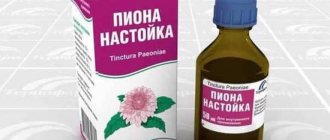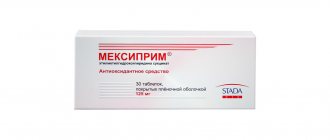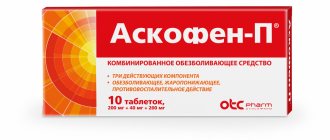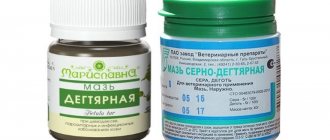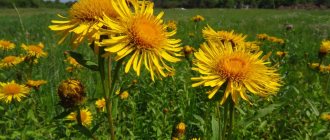Chemical composition
The following substances were found in the motherwort herb:
- Alkaloids (up to 0.4%): stachydrine and leonurine;
- Flavonoids: rutin, cosmosin, quercetin, isoquercetin, quercetin-7-glucoside, hyperoside, quinqueloside;
- Iridoids: ayugol, ayugoside, 8-acetyl-harpagide, galiridoside, harpagide;
- Saponins;
- Choline;
- Steroid glycosides;
- Diterpenoids;
- Tannins (up to 2.5%);
- Essential oil (up to 0.9%), which includes linalool, limonene, α- and β-pinene, α-humulene and caryophyllene;
- Paracoumaric acid;
- Caffeic acid glycoside;
- Resins;
- Dyes;
- Bitterness of marubin;
- Carotene;
- Vitamin C;
- Macro- and microelements.
How to prepare
This medicinal plant is best harvested during the flowering period, when its juice contains the most beneficial substances. It is advisable to take tall plants (reaching half a meter in height) and with a stem thickness of half a centimeter. Only the tops of dog nettles are suitable as a healing potion. After collection, they are spread in an even layer on paper in a warm but ventilated place and turned over from time to time. To preserve maximum medicinal components in the herb, it is important to avoid direct sunlight during the drying period. Properly dried herb can be stored for 3 years.
Indications for use
Motherwort preparations are used for increased nervous excitability, sleep disorders, cardiovascular neuroses, hysteria, hypersthenic neurasthenia, epilepsy, neurocirculatory dystonia, after influenza and other infectious diseases, for myocarditis and myocardial dystrophy, angina pectoris, cardiosclerosis, heart defects, in the early stages hypertension, climacteric syndrome, algodismenorrhea and Graves' disease.
In dermatology, motherwort preparations are used for skin itching, neurodermatitis, lichen planus, eczema and psoriasis as a sedative, as well as for microbial and childhood eczema with dysfunction of the nervous system.
Motherwort herb is included in sedative preparations.
How is it useful for humans?
From a chemical point of view, motherwort is a combination of essential oils, alkaloids, glycosides, iridoids, flavonoids, terpenoids, caffeic, citric and malic acids, tannins, choline and vitamin A.
Research conducted by the Chinese indicated that the beneficial chemicals usually contained in motherwort reach their maximum concentration during the flowering period of the grass. By the way, in ancient China it enjoyed the fame of a long-living plant. In Greece, motherwort infusions were given to pregnant women to ease the process of childbirth and calm nerves after the birth of the baby. By the way, the Hellenes called this plant “mother’s grass.” In addition, the ancient Greeks used motherwort to strengthen the heart. And in medieval Europe this herb was known as a medicine for cattle.
Today this medicinal herb is known as:
- heart tonic;
- diuretic;
- antirheumatic;
- antispasmodic;
- astringent;
- carminative;
- stimulating menstruation;
- sedative.
Motherwort is considered useful for treating mild forms of Graves' disease. It has antioxidant and immunostimulating properties and has a positive effect on the central nervous system. It is known that the juice of this herb accelerates the removal of toxins from the body, and also improves the functioning of the kidneys, liver, gall and bladder.
But motherwort is best known as a heart herb (the name of one of the varieties of this plant is motherwort). Its extract is useful in the treatment of chronic cardiovascular diseases in the elderly. Some varieties of dog nettle have sedative effects, reducing muscle spasms and lowering blood pressure. Studies have shown that the herb extract slows blood clotting, prevents thrombosis, reduces the amount of fat in the blood, and also calms an overly fast heartbeat.
Herbalists use this plant to treat rheumatism, bronchitis and asthma.
The herb extract helps with thyroid overactivity, but at the same time is completely safe for healthy people, since it does not affect the healthy secretion of thyroid hormones. In traditional Chinese medicine, motherwort seeds are known as an effective diuretic. Other beneficial properties include the ability to speed up metabolism, improve digestion, relieve intestinal cramps and reduce swelling. This plant will protect men from prostate adenoma and problems with potency.
Benefits for the Cardiovascular and Nervous System
Many herbalists believe that there is no other plant in nature that is more beneficial for the heart and nervous system. The alkaloids contained in motherwort have a mild vasodilating effect and also have a relaxing effect on smooth muscles, including the heart. Dog nettle extract has been scientifically proven to lower cholesterol and triglyceride levels in the blood, which is also important for the healthy functioning of the cardiovascular system. Having a mild diuretic effect, motherwort regulates blood pressure. In addition, it inhibits arterial calcification.
This herb has sedative properties, improves sleep, relieves anxiety, and regulates heartbeat. Tea made from it is useful for neuralgia and chronic fatigue. By the way, motherwort has more powerful sedative properties than valerian or lily of the valley. The digestive system will also feel the benefits of this tea. In particular, herbal medicine made from dog nettle improves well-being in cases of indigestion and intestinal inflammation.
Benefits for women's health
To treat female diseases, herbalists use the flowering tops, leaves and stems of the plant. Decoctions and infusions of them are useful for treating:
- amenorrhea;
- dysmenorrhea;
- uterine fibroids;
- ovarian cysts;
- endometriosis;
- postpartum depression;
- PMS.
Special chemicals contained in motherwort have been found to be gentle on the uterus during menstrual irregularities. The same herb, according to herbalists, is useful for women with painful menstruation. Infusions and decoctions of motherwort help fight anxiety, tachycardia, hot flashes, headaches and dizziness, sleep disturbances caused by PMS or menopause. In addition, researchers suggest that motherwort reduces the risk of developing uterine cancer, prevents infertility, improves female fertility, and also eases contractions. After childbirth, the plant extract is useful for calming the nerves and preventing postpartum depression (but during this period, the herb can only be taken with the permission of a doctor, so as not to cause bleeding).
During pregnancy, dog nettle is strictly prohibited, as it can cause miscarriage. Women with heavy menstruation should also avoid motherwort (as it can increase bleeding even more).
Contraindications
Plant-based preparations are contraindicated during pregnancy and after an abortion, as well as in cases of increased individual sensitivity to the components.
Motherwort is not used in patients with erosive gastritis and gastric ulcers, bradycardia and arterial hypotension.
For thrombophlebitis and thrombosis, treatment should be carried out strictly under the supervision of a physician.
Since motherwort causes drowsiness, it should not be used by people whose work requires increased concentration.
What does motherwort look like?
Motherwort is a perennial erect plant from the same family as mint (Lamiaceae), although it does not at all resemble its fragrant relative in taste or smell. On the contrary, it is very bitter, and its smell is not the most pleasant. In favorable conditions, an adult plant can form into a tall (almost 2 meters), branched herbaceous bush with hollow stems. For some people, contact with the dark green “hairy” leaves of motherwort results in itching and allergies.
Content:
- What does motherwort look like?
- How is it useful for humans?
- Daily norm and dosage
- Contraindications
- How to prepare
- Motherwort medicine at home
- Use in the food industry
- Benefits in cosmetology
At the end of June, small flowers of pink, purple or white appear on the bushes. The flowering period of motherwort continues throughout the summer. As a rule, thickets of this grass are found in damp places, near landfills, on crushed stone and limestone soil. This picky plant can appear in both sunny and shaded areas of wastelands - hence its name. But the Latin name of this plant is translated as “lion’s tail”, since during the flowering period it resembles the brush of a lion’s tail.
Homemade remedies from motherwort
- Infusion of motherwort herb: 3 tbsp. l. (15 g) of dry herb of the plant, pour 1 glass of boiling water (it is recommended to use purified or melt water) and leave for 1-2 hours. Take 1 tbsp before meals. l. up to 4 times a day for diseases of the gastrointestinal tract, in the early stages of hypertension, for nervous excitability and cardiovascular neuroses;
- Alcohol tincture of motherwort: pour 20 g of crushed plant raw materials with 100 ml of 70% alcohol, leave for 7-14 days. Use 30-40 drops 3-4 times a day for rapid heartbeat, neuroses, shortness of breath, cardiomyopathy and early stages of hypertension;
- Soothing tea: mix 1 tbsp. l. motherwort, St. John's wort, yarrow, peppermint leaves and chamomile flowers. Brew 1 tbsp. l. the resulting mixture as an infusion, take warm 30 minutes before meals, ½ cup 2-3 times a day.
(motherwort five-lobed, motherwort hairy) -LEONURUS CARDIACA L. (L. cardiaca L. var villosus Lebed.,L. villosus Desf., quinquelobatus Gilib.)
Sem. Lamiaceae (Labiatae)
DESCRIPTION. A perennial herbaceous plant up to 150-200 cm high with a woody rhizome, densely planted with roots. The stems are numerous, straight, moderately branched, tetrahedral, densely pubescent, and often have a red-violet color. The leaves are opposite, petiolate, dark green above, grayish below, pubescent. The lower leaves are larger, rounded in outline, with a heart-shaped base, palmately five-parted almost to the middle into oblong coarsely toothed lobes; middle ones - oblong-elliptical, tripartite, coarsely toothed; apical ones are simpler, narrower and solid. The flowers are collected in dense opposite half-whorls in the axils of the upper leaves, forming a long, discontinuous, spike-shaped inflorescence. The calyx is regular, tubular-bell-shaped with 5 subulate-pointed teeth. The corolla is two-lipped, twice the size of the calyx, pink or pink-violet. The upper lip is helmet-shaped, densely pubescent, the lower lip is three-lobed. There are 4 stamens, protruding from the corolla tube; pistil with a long bi-split column. The fruit is composite, breaking up into 4 triangular dark brown nuts. Blooms from June to September; the fruits ripen in September-October.
RAW MATERIALS. Medicinal raw material - motherwort herb (Herba Leonuri), consists of the tops of stems with flowers and small leaves. The presence of stems more than 4 mm thick in the raw materials is not allowed. Raw materials collected late, after flowering, when the calyxes become hard and very prickly, are unsuitable. The smell is weak herbaceous, the taste is bitter.
DISTRIBUTION AND PROCESSING. It grows in wastelands, near housing, in vegetable gardens, fallow lands, grazing meadows and among thickets of bushes.
The reserves of raw materials are significant, allowing for the production of commercial preparations. The grass is cut during the flowering period and dried in the open air or in a well-ventilated area. Shelf life - up to 3 years.
CHEMICAL COMPOSITION. Choline, stachydrine and a base of unknown nature were found in the herb of motherwort, as well as tannins, saponins, sugars, ascorbic acid, flavone glycosides: rutin and quinqueloside; the latter contains the aglycone apigenin, d-glucose and n-coumaric acid, vitamins A and C.
APPLICATION. It has been established that motherwort preparations have a calming effect on the central nervous and cardiovascular systems. They lower blood pressure, slow down and increase the strength of heart contractions, improve sleep, and reduce headaches. Motherwort is used as a sedative for cardiovascular neuroses, cardiosclerosis, increased nervous excitability, and early stages of hypertension. By the nature of the action, its preparations are close to valerian preparations. A liquid extract (Extractum herbae Leonuri fluidum) and a tincture (Tinctura Leonuri) are available. Together with valerian, motherwort is part of a soothing tea.
In folk medicine, preparations based on motherwort are used for neuroses (as a sedative and anticonvulsant), constriction of blood vessels, low blood pressure, heart failure, delayed or painful menstruation, as a diuretic and cough sedative.
RECIPES
Infusion:
Pour 2 teaspoons of crushed raw materials into a glass of cold water (daily dose), leave for 8 hours.
Powder:
dosage: 2-4 g per day.
Fresh Juice:
Dissolve 30-40 drops in a spoon of water and drink 3 times a day for Graves' disease and impotence.
The juice can be preserved for the winter: mix 2 teaspoons of juice with 3 teaspoons of alcohol.
Benefits in cosmetology
Thanks to its unique chemical composition, motherwort is a good raw material for cosmetics.
For hair
Best materials of the month
- Coronaviruses: SARS-CoV-2 (COVID-19)
- Antibiotics for the prevention and treatment of COVID-19: how effective are they?
- The most common "office" diseases
- Does vodka kill coronavirus?
- How to stay alive on our roads?
Dog nettle decoction is especially beneficial for oily hair. For rinsing curls, a decoction prepared from a tablespoon of herb and a liter of water is suitable (cook for 5 minutes, then leave for 3 hours). Dilute the finished infusion with 3 liters of clean water. Rinse clean hair with the resulting liquid.
Motherwort, nettle and oak (in a ratio of 1:2:2) are also good hair remedies; in particular, a decoction of these plants, when rinsed regularly, makes hair shiny and prevents hair loss. Instead of nettle, you can also take burdock root.
You can restore shine and healthy appearance to dry hair using a herbal mask. Mix castor oil, calendula and motherwort tinctures in equal portions, add a little water. This product must be applied to the hair and left for about an hour.
You can also strengthen weak hair with the help of plants. To do this, take motherwort, oak bark and onion peel in equal quantities. For 5 tablespoons of the mixture you will need 1 liter of water. Steam for about an hour. Cool the finished broth and strain. Rub into scalp before washing.
Where does motherwort grow?
In Russia, the plant is found in many areas and is considered a European-Caucasian species. The edge of its range extends into Western Siberia, but is more common in the European part of Russia.
Motherwort cordial grows in the more southern regions of the European part and in the Caucasus. In more northern and eastern regions, motherwort five-lobed grows. But medically, these two types are exactly the same.
Motherwort five-lobed. Photo: Yandex.Pictures
To obtain medicinal raw materials, the plant is cultivated in small areas in specialized farms.
